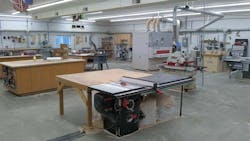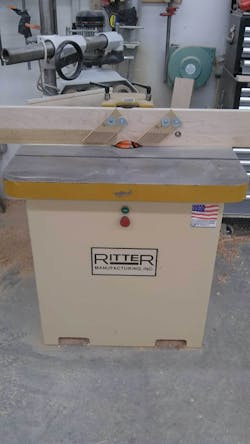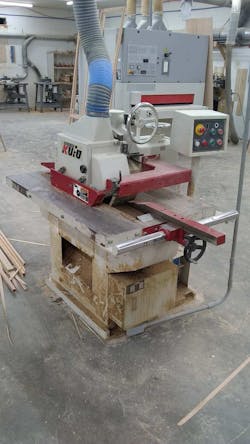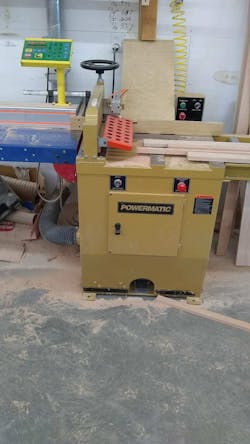Powering Three-Phase Equipment as Easy as 1-to-3 for Custom Cabinet Maker
Like many businesses, Wray’s Woodworking started as a hobby. Now, after nearly two decades of supplying custom residential cabinets, the business is well known for its quality craftsmanship and attention to detail. While customers appreciate their crisp mitered corners, and the silky-smooth surfaces of the cabinet facings, they give little thought to the band saws, planers, and sanders required to ensure that precision—or the difficulty in operating such equipment on single-phase utility power lines. Thanks to a 1-to-3 MicroGrid Power Supply from Single Phase Power Solutions, lack of three-phase utility power is no longer a problem for Wray’s.
Nestled in the countryside of northeastern Kansas, Wray’s is about 50 miles from Kansas City. And while that distance is close enough to catch a Royals game, it is still out of reach for three-phase electrical lines. Single-phase service is all that is available. In fact, for a long time, the workshop adjacent to Wray’s home still operated off the residential electric meter. Although the system he was using—generating three-phase power from a pair of rotary phase converters (a 30 and a 50 HP unit) which were powered by single-phase utility lines wasn’t ideal, it was functional. For the most part, that is.There were occasional instances where they’d trip a breaker, generally during the heat of the day when they (and the neighbors) were running the air conditioning. With average summer temperatures in the 90s, you can understand why.
“In the summertime, we run air conditioners in our shop,” said owner Nathan Wray. “Everyone else was running their AC too, and it was pulling too much (amperage), so we were tripping breakers because we didn’t have enough power.”
And starting up the rotary phase converters was a little dicey because of the inrush current required—the 50 HP unit alone drew about 400 amps, which caused lights to dim downstream from Wray. While these are nuisance problems, Wray encountered more serious issues when he went to upgrade the meter to commercial service.
The local power utility, KCP&L, reviews all of the equipment being powered on the service as part of their approval process for installing new meters. They did not approve of the phase converters and would not upgrade the meter. The large inrush of amps during startup of the rotary phase converters caused a sag in the power supply downstream from Wray, resulting in dimming of lights and poor power quality for downstream customers. He found a solution in Cincinnati via the Topeka Farm Show.
Single Phase Power Solutions manufactures high-horsepower single-phase motors as well as the 1-to-3 MicroGrid Power Supply which generates three-phase power from single-phase utility power. The company had exhibited at the Topeka Farm Show, where Wray’s father, who farms 1,000 acres nearby, saw them. The younger Wray reached out to SPPS and the dialogue resulted in the purchase of a pair of 50 HP 1-to-3 units. The two units have been installed for over a year, and Wray is pleased with their performance.
How they work
The 1-to-3 MicroGrid Power Source features a BELLE Motor which uses Written-Pole technology to deliver three-phase power from single-phase utility service. A Written-Pole single-phase motor can drive a three-phase conventional generator to produce clean, balanced voltage. The proven converter circuit can start multiple smaller 3-phase motors. The 1-to-3 can start a single motor up to about 50% of its rating, and other smaller motors up to its output rating, thus providing flexibility and cost savings.
In Wray’s case, he uses one of the 1-to-3’s to power a three head wide belt sander, and the other 1-to-3’s to power the remaining equipment.
“The sander pulls about the same amperage as the other equipment together,” said Wray, so it made sense to power it separately. The other 1-to-3 powers a 15 HP straight line rip saw, a 10HP upcut saw, a 7.5 HP sliding table saw, and a 5 HP shaper.
Power Quality
The 1-to-3 allows weak single-phase lines to deliver strong three-phase power with excellent voltage regulation and precise 60 Hz frequency. The generator output voltage provides well-balanced three-phase power capable of starting and running large three-phase motors and power quality-sensitive electronic controls. This equipment isolates the application (and the utility) from harmonics that are harmful to sensitive loads.
Efficiency
Written-Pole motors start using only 1.7x their rated running current, about 150 amps for Wray’s operation. This eliminates the excess voltage sag or “flicker” that can cause problems on distribution lines. The efficiency rating of the motor is 95.5% and the generator efficiency is 93.5%, resulting in an overall efficiency of 89% with 10% electrical isolation. With the 1-to-3 MicroGrid Power Source, customers served by single-phase lines can get high-quality power for three-phase applications. Unlike conventional phase converters, the 1-to-3 provides true, balanced, three-phase power, eliminates disruptive harmonic feedback, is a unity power factor load to the utility, and with an added flywheel, can ride through momentary power interruptions with ease.
Cost-Effective and Ongoing Cost Savings
Extending three-phase distribution is expensive, typically between $30 to $110K per mile. Using a 1-to-3 MicroGrid Power Source avoids that cost. Utilities often amortize the high cost to extend distribution, charging customers monthly fees whether they use the power or not. Use of a 1-to-3 Power Source avoids these charges, which can range from $12 to $60K per year. The highly efficient written-Pole Motor driving the 1-to-3 achieves a full load efficiency exceeding 88%, which can reduce energy costs by thousands of dollars each year. Since the 1-to-3 input runs at unity power factor, there is no power factor penalty, a potentially significant cost avoidance.
Installation of Wray’s 1-to-3’s was simple and was accomplished by a local electrician. During startup they experienced some nuisance tripping of breakers, so he contacted the SPPS factory team. They set up a system in their Cincinnati shop under a similar load and could replicate the problem. Upgrading the software card in the control panel resolved the issue, and it’s been smooth sailing—or rather cutting, since then.
“The 1-to-3’s give us stable power that we can count on,” said Wray. “We can run all of the equipment simultaneously now, along with the air conditioners, and there is no dimming or power sag.”
Installation of the 1-to-3 MicroGrid Power Supply cleared the hurdle established by the local utility and allowed Wray to install 480V commercial meter service for the woodworking shop. More importantly, it allows Wray to run all of his equipment simultaneously so that he can continue to make more cabinets for his growing customer base. Keeping his workers cool and productive without adversely impacting downstream power customers is also important—not just to the workers and downstream customers but also for the local utility provider. Keeping everyone happy without incurring the cost to run three-phase power to the area is another benefit to all involved.




